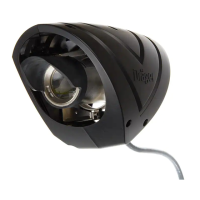Installation of a Dräger Polytron Pulsar 2
9
Installation of a Dräger Polytron Pulsar 2
Choosing the path of the beam
1 The siting of an open path gas detector is often not as critical as a point detector, since the released gas only has to find its way into
some portion of the beam instead of to a particular point. However siting is still an important consideration. Guidance for siting is con-
tained in EN 50073.
2 Dräger Polytron Pulsar 2 is immune to sunlight so there is no need to take account of the sun position when siting detectors.
3 The density of the gas to be detected has to be considered. Methane is lighter than air and may be expected to rise, unless released
at a low temperature or in a mixture with a heavier gas like carbon dioxide. Likewise heavier hydrocarbons may be expected to fall.
However such simple considerations as buoyancy may not be a reliable indicator of gas movement in practical situations. Gas leaking
from high-pressure systems entrains with it a much larger volume of ambient air, forming a mixture that may be flammable and almost
neutrally buoyant. In these circumstances it is the natural air currents or forced ventilation that control the motion of the plume or cloud.
Where air movements are unpredictable it may be necessary to use separate beam paths to cover different possibilities.
4 The distance between the Transmitter and Receiver should agree with the model selected (i.e. 4-60m, 30-120m or 100-200m). Note
that the Optical Attenuator should be fitted below 16 metres.
5 The beam path and immediate surround should be kept free of obstructions that might hinder the free movement of air in the protected
area or block the infrared beam. A clear path of 25cm diameter or greater is recommended. For maximum availability it is also recom-
mended to avoid the following:
— Smoke stacks, chimneys and exhausts.
— Steam vents and plumes.
— Walkways and areas where personnel muster or collect.
— Splash and spray from moving equipment and cooling towers etc.
— Parking, loading, cranes, vehicle temporary stops.
— Vegetation that may grow tall enough to impinge on the path especially with movement by the wind.
— Surfaces that may obstruct the beam path with a build up of ice or snow.

